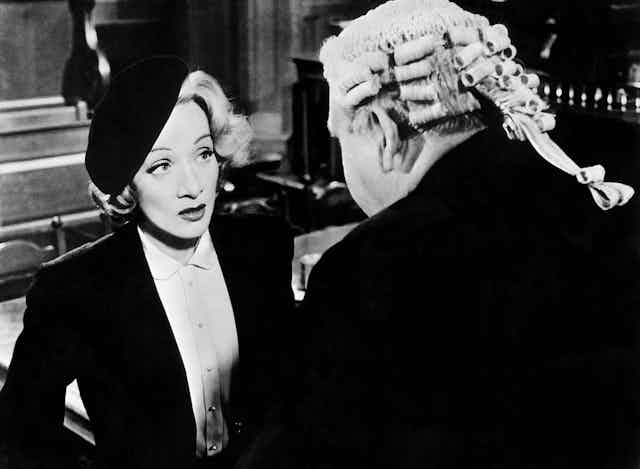You might think attractive people get preferential treatment in life – and research suggests you’d be right. Some psychologists have shown this can even help people get a lighter prison sentence. More recently, however, our own study suggests that this “halo effect” is, in fact, more complicated.
The halo effect is a psychological term describing how an initial good impression of someone positively colours our subsequent perceptions of them.
Our first impressions are formed quickly when we meet new people and they bias how we behave towards them. When we judge a person to be attractive, this can cause us to believe they also have other socially desirable traits, such as being interesting or funny.
Studies show that, as a result, attractive people may receive more help from strangers, earn higher wages, and get more job opportunities.
Cognitive biases
One place in which you’d really hope that appearance doesn’t affect decisions is in court. The problem, however, is that jurors show biases just like other people.
Studies into real cases have found that inmates who people think look less trustworthy may be more likely to receive death sentences, while baby-faced defendants in small claims courts may be more likely to win cases involving intentional actions. And, as you might now suspect, more attractive defendants seem to receive more lenient sentences.
That said, it can be difficult to work out the causes of effects found in studies conducted in real-world situations, and there are often many possible explanations. For this reason, studies in the laboratory can be the best way to investigate specific research questions.
In lab studies, participants typically feature in the role of mock jurors. Again, these tend to show evidence that attractive people receive more lenient punishments for most types of crime.
Attractiveness doesn’t always influence mock juror decisions though. The attractiveness of the defendant may interact with other factors, such as the attractiveness of the plaintiff or whether the jurors have a chance to deliberate with each other.
However, previous laboratory-based studies also show limitations. First, they often focus on only one type of crime, so it isn’t clear whether attractiveness may play a role in the sentencing of some crimes but not others. Second, these studies present a single image of their supposed criminals even though real juries typically see defendants moving around and from different angles, which could change jurors’ perceptions of defendents’ attractiveness.
Finally, many studies investigate the impact of attractiveness by comparing decisions based on just one “high attractive” versus one “low attractive” defendant. In reality, attractiveness is a continuous measure, so this simplified comparison of the two extremes may not show what’s really going on. Plus the two faces chosen are unlikely to be representative of all such faces – a particular face might be very attractive, but will also have many other specific qualities that make it different.

New findings
In a recent study, my collaborators and I tackled these limitations by including several different descriptions of crimes, supposedly perpetrated by the defendant, for each of three crime types (robbery, sexual assault, murder).
We also presented short video clips to our mock jurors rather than photos of the defendants. Finally, we used 60 different “defendants” varying in attractiveness. In this way, we hoped that our findings might better apply to the processes evident in the real world.
During the experiment, some of the participants judged the attractiveness of the defendants. On each of the 60 trials, they were presented with a five-second video clip of a smartly dressed man testifying in court (with the sound removed) and rated the attractiveness using a zero (very unattractive) to nine (very attractive) scale.
Other participants judged the perceived guilt of the men (again, with the sound removed to avoid being influenced by what was being said). Each video clip was accompanied by a crime description and participants rated whether they thought the man was innocent or guilty using a zero (definitely innocent) to nine (definitely guilty) scale. We then used the men’s attractiveness ratings to see if these predicted the guilt ratings they received.
Our results provided some evidence that more attractive defendants were rated as less guilty of murder but more guilty of sexual assault, with no bias observed for robbery. However, these effects were all small in size. In other words, even if there was some influence of attractiveness on perceived guilt, it would be of little importance in the real world.
Given that researchers typically find that more attractive people receive lighter sentences, we argue that the lack of an effect of attractiveness in our study is likely due to the improvements in our design. Of course, there are still many differences between our study and jurors’ experiences that we didn’t investigate. For instance, the way that defendants speak in court may influence perceptions, as might their gender.
Since attractiveness is known to bias judgements in a number of contexts, why might it fail to influence decisions of guilt or innocence in court?
We suggest the seriousness of the crime could trump any biases due to the defendant’s appearance. Although we may think more favourably about attractive people in daily life, this halo effect could dissipate when we are faced with decisions about robbery or murder.
In such circumstances, we would hope that the evidence carries most of the weight in our decision-making processes.
Although there may be good reason for jealousy when considering the way attractive people are treated in general, justice may overcome such things in the courtroom.

